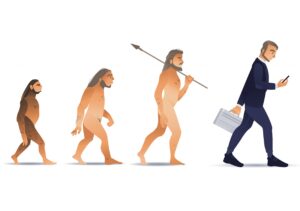
Ever felt defeated under the pressures of your leadership role?
Almost two decades ago I discovered the work of British-American philosopher, Alan Watts. Watts had become best known during the mid-20th century for writings that interpreted and popularized Eastern philosophy for Western audiences. In his 1951 novel, Watts explores humankind’s quest for psychological security and stability in an age where human existence already seemed fraught by the growing instabilities of change and uncertainty. He proposed that humanity, faced with the many potential threats of this existence, spends the majority of our time trying to control the future and mourn the past, while all along failing to truly experience and embrace the present moment; the “here-and-now”. And it’s the present where all the action ultimately takes place.
According to Watts, our ongoing obsession with the past and future creates a constant state of self-imposed anxiety and insecurity, brought on by our constant efforts to know and control things from the past and future that we can’t truly know or control. Stuck in ponderings of yesterday and tomorrow, we lose touch with the only moment we’re even truly capable of experiencing – this one, right here and now. Watts’s remedy for this soul-stifling state of insecurity lies partially in letting go of our past and future obsessions and embracing all of those possible outcomes openly, without judgment, as they come, so we can finally get on with existence in the present and allow our inner peace and wisdom to manifest. The novel was entitled, The Wisdom of Insecurity, and it was my personal introduction to Zen Buddhism.
In our lives today we most certainly continue to face greater and greater change, risk and instability. With ever-increasing population growth, rapid technological advancement, political turmoil, perplexing social dynamics and a further distancing between ourselves and the natural world – atop the pressures of daily life to boot, including our professional engagements, bills, relationships, kids (and all the pressures they face) – it’s no wonder that depression rates, substance abuse, suicides and our collective anxiety keep rising. We appear to only be getting more stressed out, less fulfilled and further from inner peace and balance. As if that’s not enough to make it challenging to get out of bed each day, the business owner can also add the pressures of running a business.
Running a business, if it were to always work miraculously – operations flowing like a calm river, costs remaining as predictable as water from a tap, staff as happy as children eating melting ice cream at the beach and revenue rushing over us in waves – there’d quite likely be so much less to stress about. But that’s an imaginary business at best. Many of us have been pushed further than we’d ever imagined possible just to keep things going.
If it were easy to run your own show and be your own boss, more of us would do it. The reality is that our businesses, when we truly give ourselves to them, offer plenty of very real reasons for worry and wear. Particularly with small businesses, the risk of failure is high and the ebb and flow of short-term prosperity and challenge can be chaotic. Running your own operation can be enough to keep you sweating and fatigued. And all along, these pressures and anxieties can distract us from truly engaging in the most critical moments – those in the here-and-now – where we can actually gain the greatest benefits and exercise our greatest influence.
Before proceeding, I feel compelled to apologize to Mr. Watts, who, I fear, would from the grave, look upon my applying his philosophies to business in a semi-bastardized fashion and think, “I believe you may have missed my point.” However, if you consider your own professional existence within your broader human story – as part of your collective mind-body health – it becomes easier to see the direct connections between our personal, spiritual and professional existence. If Watts (and perhaps to a degree, Zen Buddhism in a larger sense) is correct in surmising that so much of our inner-conflict and struggle comes from our failure to openly embrace the present in all its glory and gloom, good and bad, yin and yang, openly and without judgment, would there not be value in exploring the remedy for that constant state of anxiety and lack of fulfillment?
I have found in Watts’s teachings, relevant life lessons worth applying to professional life and leadership as well. These lessons focus on openly embracing the present and all the insecurities that inevitably come with business risk.
Lesson #1 – Heed your holistic health (mind, body and spirit)

Furious arguing business team and CEO meditating in lotus position on the table
Our mental health affects our physical existence. In fact, it arguably effects most everything we do, at least on some level. It’s usually pretty obvious to us when challenging work conditions impose stress and strain upon our human mind-body machines. Even if we’re really good at managing our stress and believe we’re great at hiding its effects on us, our being anxious, not at peace and never quite fulfilled damages our health and hinders our abilities in so many ways. In that state, we risk compromising our decision-making and professional relationships, as well as carrying that baggage around with us wherever we go.
On the other hand, when we have the tools to better cope with and navigate through our moment-to-moment environment, we gain optimism and confidence. By Abraham Maslow’s hierarchical standards (a different discussion for a different time), with our basic needs satisfied, we get the opportunity to move on to grander things like deeper engagement in love, spirituality and self-realization. Beyond that, it simply feels far better to feel holistically good and healthy. Alternatives – like feeling crummy – just aren’t sustainable in any good way.
Now, before moving on to Lesson 2…
If Watts was correct, much of the strain and lack of fulfillment we experience stems from our inability to secure our expectations precisely how and when we’d envisioned them. When we place so much emphasis on evaluating the past or planning for the future, we risk sacrificing experience and actions in the present, where we have the greatest chance of witnessing truth and achieving influence. We surrender the benefits of the present in exchange for academic intangibles and philosophizing which reign primarily over moments occurring some other time, where we have very limited control or influence. In formal and informal planning, we set expectations and strive to predict and control related factors in hopes of achieving those specific ends. Then, when we meet those future moments in the present, we tend to mentally step out of the moment to judge those experiences through qualitative filters like “favorable” or “unfavorable”, relative to how they match our previous expectations. Those very expectations we had to try minimizing anxiety and insecurity come to contribute significantly to expanding them.

Despite our constant pursuit of pleasure and fulfillment, our environment continually presents change, challenge, opportunity and uncontrollable elements which seem to combat our pursuits. Even when we meet any of those expectations, we’re immediately presented with new expectations to pursue. We’re constantly chasing an ever-threatening beast we just can’t catch. We set ourselves up for failure and, like Sisyphus, become engaged in a constant struggle in which we make only marginal advances at best. The continual lack of fulfillment, relative to those expectations, creates a building agitation as a self-imposed condition of our very existence. Our paradigm of planning, pursuit of those plans and evaluation of those plans can absorb and distract so much of our focus away from the here-and-now and in turn, unfavorably influence not only our experience of the present, but also the very outcomes we set out to accomplish in the first place.
That all brings me to the second lesson.
Lesson #2 – Enjoy the ride

Especially if we do what we do out of passion for what we do, things that detract from our joy and passion can work to strip the joy and passion away altogether. If I live burdened under unproductive worries pondering the past or the threats of the inevitable changes ahead, regardless of how pressing they may seem, my ability to find passion or fulfillment in my work today becomes greatly hindered, or even impossible. I might momentarily enjoy results, but I’m not truly embracing a present existence ripe with infinite possibility. If you’re ever finding that all the pressures of running your own business take the fun out of it, then don’t immediately leap to the business concept, the model or the circumstances for answers. The solution likely lies in you and your outlook.
Consider changing your approach for how you face the elements that make up your experience. Navigate by the stars, find your true north again, and steer the ship as appropriate, ready to face the unpredictable. If you can restore your inner balance, you’ll have a much better shot at realizing your vision and enjoying the ride again. We only truly realize our traces of genius in the present. The rest is mostly lamenting on the acknowledgment of it.
Lesson #3 – Embrace wellness to enhance performance
If any solutions – Zen or otherwise – enhance our wellness, that wellness will enhance our performance. Beyond improved physical, mental and spiritual well-being, there are a number of additional practical performance benefits that can result from heeding Watts’s teachings. If we openly accept and embrace all the uncertainty, change and insecurity we face in business, welcoming it all, the good and bad, the frightening and the familiar, and set aside our qualitative judgments of those experiences (as “good” or “bad”), simply seeing them as “being” when they are, then we accomplish more than simply defeating the anxiety and strain in our lives. We also gain more power and influence over our day-to-day business experiences and how we respond to them. And we gain more time to apply ourselves where (and when) it counts, which is beneficial from a cost-containment perspective, as well as when considering opportunity costs.
Our wellness, also makes us more a well-oiled machine of mind, body and spirit which, like a well-maintained vehicle, optimizes our performance as a leader and our contributions as human being. We work better, cleaner and smarter. We’re also more productive and efficient than we could otherwise possibly be. In no other area is this more important than with our relationships.
Customer, employee and partner relations – from the boardroom through the supply chain to the homes and offices of our customers – influence every aspect of our success. Our wellness heavily influences all of those relationships, what we bring to them and how those individuals respond to that which we bring. Enlightenment reveals truth and truth manifests as authenticity. A state of inner-peace and grace which facilitates our real-time, in-the-moment focus on each and every individual we encounter, moves us and the work we do closer to authenticity, to rightness, to Zen. If we expect that change to fall upon us from the will of someone or something else, we’ll be forever unfulfilled by that expectation. The change must first come from within us.
Am I suggesting that small business success comes from giving up planning? Or that you shouldn’t evaluate the past to improve how to improve?
Not at all.
From a practical perspective, much of Watts’s teachings have seemed to me, contrary to the demands of human life and our ability to address those demands in a practical manner (although many of them are arguably self-imposed). The personal hindrances that restrict my own full embracing of Watts’s teachings find their origins in the gaps between philosophical evaluation and practical modern life. So yes, please do learn from the past. Just don’t dwell on it. And yes, plan in order to be your best in the moments ahead.
What I’m really advocating for is a greater focus on each moment, each experience, each relationship, as they happen in the now. It is in the present, not the past or future, that we have so much opportunity to share, learn, teach and embrace our existence together. Take a tip or three from Alan Watts and try to strike a new balance between the “what” you were and want to be (i.e. your expectations) and the “what” which is in this very moment, right now, and the next moment… until our moments have passed for good.







